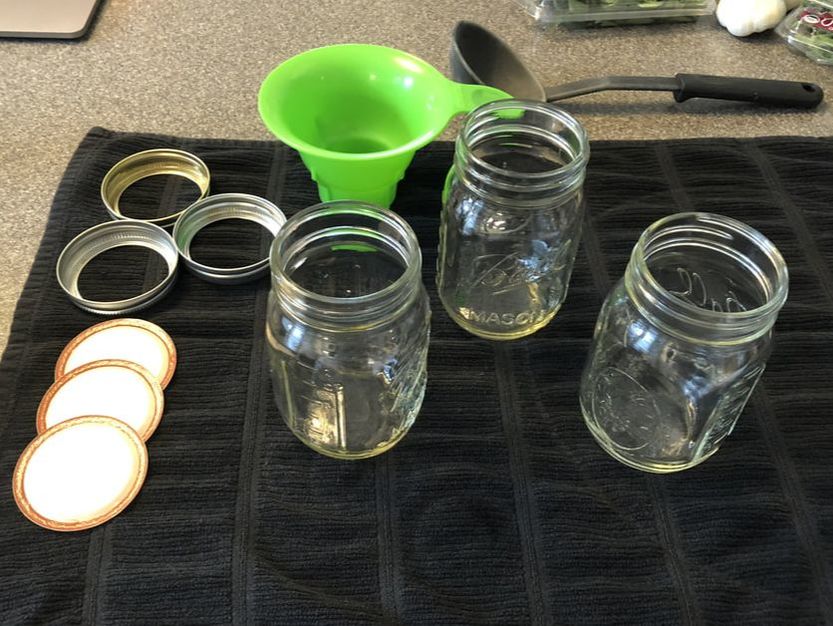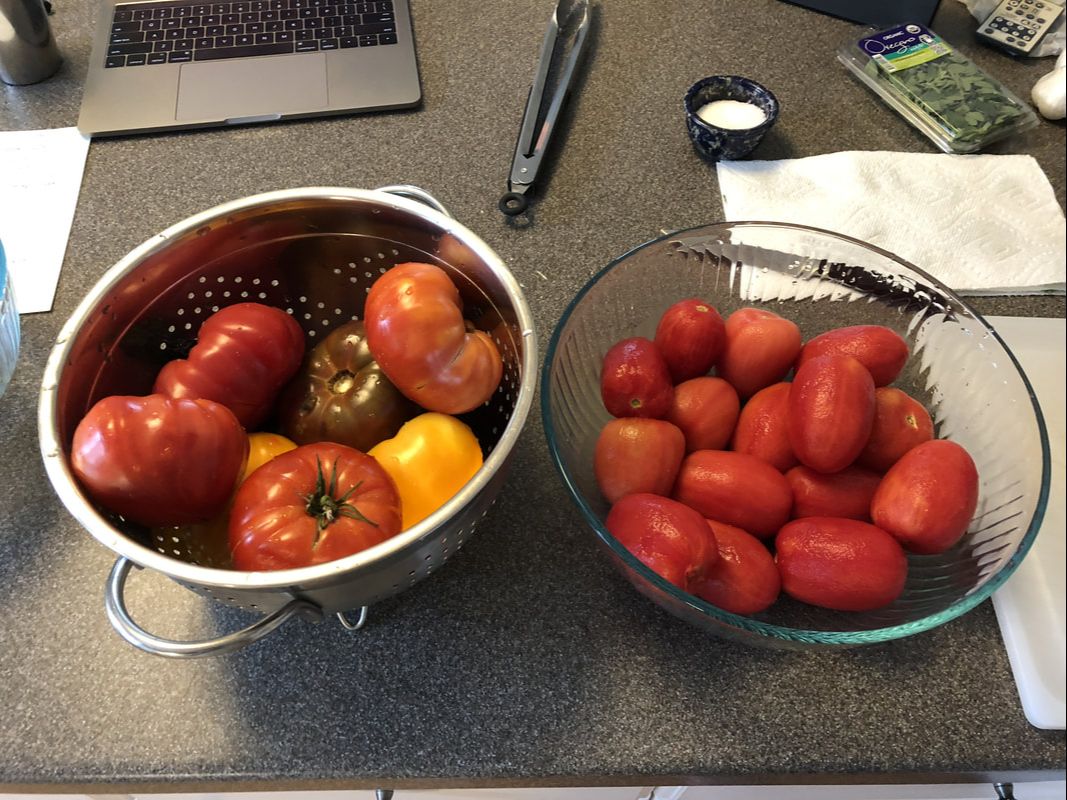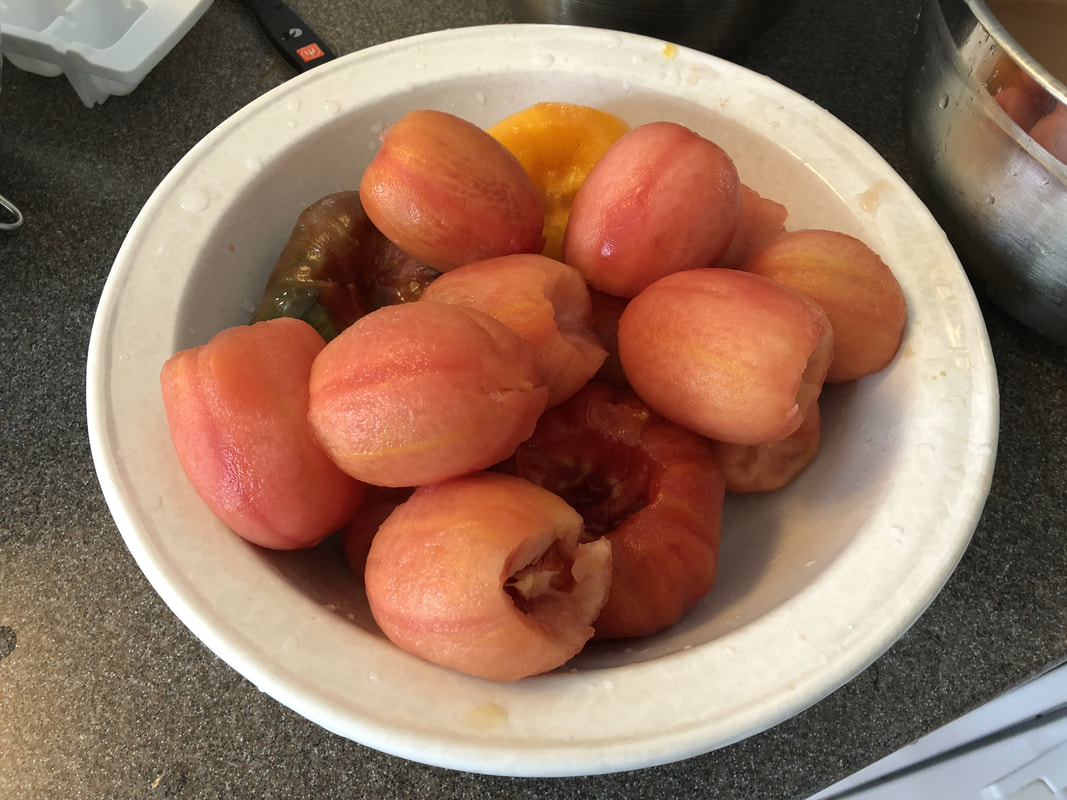|
For those of you that have been following the saga of the sauce, I’ll begin with a brief update. I’ve harvested my first batch of tomatoes (Cherokee Purples) from the tomato patch, but they’re still not quite ripe enough for sauce-making. The next round of sauce-making, however, was a substantial improvement over the previous. I started with much riper (store-bought) tomatoes, and I followed a recipe that I found on a blog site, (more on this below) a simple recipe that made a delicious sauce. I am more than satisfied that the first objective of my challenge: to learn to make a tomato sauce from fresh tomatoes - has been accomplished. The second objective: canning said sauce - has proven somewhat more elusive. While I did successfully can the most recent batch of sauce using a pressure cooker, I did not use a USDA approved recipe, and therefore might be at risk according to some. Herein lies the challenge. Tested and approved recipes are important for canning - nobody wants botulism. Tested and approved recipes, however, are somewhat uncommon, and often pretty basic. Making delicious sauce? Check. Canning sauce? Check. Canning the delicious sauce? Not recommended by the USDA.
I’ll continue to try out new recipes, particularly once my tomato crop is fully ready. I intend to experiment with some basic USDA recipes for canning tomato sauce, but I also intent to simply can fresh crushed tomatoes, in order to give myself more flexibility with recipes. While it won’t be ready-to-eat out of the jar, I’ll be confident that I’m not going to get sick. Plenty of folks that I heard from in the videos and blogs I read assured me that “my Granny’s been doing this for 300 years and she ain’t never got sick!” I’d like to believe them, and my intuition tells me that certain methods should be safe, but if I’m going to be feeding my family (including young children), it’s probably best to air on the side of safety.
The entirety of this learning process was done through networked learning. I intentionally depended on networked “human” sources - YouTube videos, blog posts, forums - rather than traditional sources like recipe books. The recipe that I most recently discovered was on a blog called Smitten Kitchen. The post was titled “naked tomato sauce,” and in the words of the author, “The tomato flavor is so pure, so clear, so tart and sweet and roasted all at once, I was desperate to crack the code…” That sounded great, and I can largely corroborate her findings. One of the fascinating things about networked learning is that the resource you’ve discovered is often already several steps along the network. The previous quote continues, “...and it didn’t take long for Google to unearth for me the secret ingredient: Nothing. Nothing! Not onions or carrots or celery. No tomato paste, no slow-roasted garlic, no tomato variety so rare, you’ll need a second mortgage to even be allowed to look at it. The recipe for the sauce is pretty much just tomatoes, cooked until saucy.” The blog that I was reading wasn’t claiming to own the recipe, but was actually relaying a review and lightly modified (remixed) recipe from her network. The greatest challenge of using only networked resources for this learning project was that the official recipes, guidelines, and techniques for canning safely were generally off-limits. The great benefit of it is that you gain insights, opinions, ideas, and tangential information that you would never come across in the straightforward canonical, authoritative guide. Furthermore, you have the opportunity to engage the resources you come across through comments and messages. While it will be a relief to be able to consult the “official” sources for the next batch, I encourage you all to explore the full wealth of available networked experience and knowledge when you embark on your next learning project. Check out the video below for some saucy tips and tricks.
2 Comments
I made sauce! It was ok. After watching several YouTube videos and reading a few blog posts (sources below), I felt confident that I knew enough to get started. I certainly will not have 10,000 hours to practice my sauce making, so it was important to start practicing quickly. One of the challenges when making sauce for canning is that there are strict safety guidelines for long-term preservation. The USDA strongly discourages people from canning “any old” recipe, and instead recommend sticking to a carefully tested recipe. Any sauce that is canned using water-bath canning techniques (boiling water) cannot have any oil or meat - those recipes require a pressure canner (higher temperatures kill all bacteria, including botulism spores). Furthermore, the canning process continues to cook the sauce, and so the canning time must be taken into account when deciding where the sauce should fall on the spectrum from “fresh” flavor (short cook time) to “deep, rich” flavor (long cook time). As a first attempt, I decided to try a simple and straightforward approach, and avoid canning altogether. Once I am able to refine a simple recipe, I’ll work to adapt it to preservation. I tried a mix of tomatoes based on the advice of this guy at SeriousEats - as his name implies, he seems to take his craft seriously. He knows what he’s looking for, and is able to articulate how he makes it happen. His recommendation is to make a tomato paste in the oven (low and slow heat) for a deep, rich flavor component, a simpler “base” sauce with a blend of varieties, and a fresh component, cooked only for 10 minutes to preserve the flavor. They’re mixed together just before serving. Various other sources that I found on YouTube and blogs used a wide range of recipes - from canned tomatoes and dried herbs, to artisan recipes with only fresh, organic ingredients, to hearty sauces with peppers and mushrooms. While the tomato garden is growing well, the future sauce fruits are very green and far from ripe. Due to the time constraints of this learning project, I needed to purchase tomatoes for this first learning batch. This is where I learned my first major lesson: all the YouTube wisdom in the world can't make up for mediocre tomatoes. The tomatoes at the local farmer's market beckoned, but there were no plum tomato varieties (also called "paste" varieties, these are ideal for sauce because of their high flesh to water ratio, and few seeds). The supermarket was the next stop, and this was where things went downhill. The heirloom varieties that they offered were fine, but the plum tomatoes were hard and underripe. Although any honest midwestern feller would have scoffed, my simple city-dweller eyes were fooled. While the tomatoes looked sufficient in the store, you can see in the photo above that the pale, pinkish peeled fruits were merely imposters, feigning tomatohood. Without other options readily available, I decided to continue on, knowing well that this was a major compromise. Details will come as my technique is refined, but suffice to say for now that it turned out OK - even with compromised ingredients. I am generally encouraged, and convinced that with better, riper, fresher fruit and herbs, the end product will be substantially enhanced. My next steps are to try a second round with better ingredients, a third to refine the recipe, then subsequent tests to figure out a cooking and canning technique that preserves the flavors that I’ve created. Stay tuned! Resources: https://www.youtube.com/watch?v=Aqh3QfYHyRs https://www.youtube.com/watch?v=hvawBQeGZvU https://www.youtube.com/watch?v=RPKv9jw5Qz4 https://www.youtube.com/watch?v=yn5RtE82RVo https://www.youtube.com/watch?v=moNauSpPhzw https://ask.extension.org/questions/155387 http://foodinjars.com/2010/08/canning-101-why-you-cant-can-your-familys-tomato-sauce/ https://ask.extension.org/questions/421172 http://www.askaprepper.com/canning-pasta-sauce-long-term-preservation/ https://melissaknorris.com/make-can-tomato-sauce-waterbath-pressure-canning/ I can't claim to have a Nonna, or even any substantial Italian heritage, but I do have an appreciation for a "just right" tomato sauce over fresh, perfectly al-dente pasta. My wife and I go through so much pre-made pasta sauce and salsa each year, that this past Spring, I embarked on a tomato-growing adventure. The picture above captures about a dozen tomatillo plants, nearly 50 tomato plants (half "Amish Paste" and half "Cherokee Purple"), and a handful of hot pepper plants, on a piece of land graciously lent to me by my school. The idea is that the tomatoes will yield an enormous crop - plenty for all the fresh eating we can imagine, and plenty left over for all the cooking and preserving that we have the time or energy to take on.
The potential hitch in the plans is that I've never grown more than a couple tomato plants in our city-sized side yard, and have never actually made tomato sauce or salsa from fresh tomatoes. I'll take on the challenge of learning how to cook and can (mason-jar) delicious pasta sauce for my "Networked Learning Project" - a part of my first year experience in Michigan State University's MAET graduate program. I'll avoid online recipe books (traditional media, just stuck online), and instead focus on the strong opinions and unique experiences of YouTube amateurs and online forum contributors, who I'm sure each believe wholeheartedly that their technique is the one-and-only "best ever." Stay tuned for the inevitable trials and tribulations of Nate's Sauce, v1.0. |
AuthorNate is the Director of Technology at the Roxbury Latin School Archives
January 2019
Categories |
















 RSS Feed
RSS Feed
